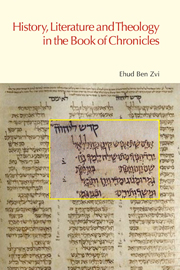Book contents
- Frontmatter
- Dedication
- Contents
- Acknowledgments
- Abbreviations
- Part I INTRODUCTORY ESSAYS
- Part II CHRONICLES AND THE REREADING AND WRITING OF A DIDACTIC, SOCIALIZING HISTORY
- Chapter 3 OBSERVATIONS ON ANCIENT MODES OF READING OF CHRONICLES AND THEIR IMPLICATIONS, WITH AN ILLUSTRATION OF THEIR EXPLANATORY POWER FOR THE STUDY OF THE ACCOUNT OF AMAZIAH (2 CHRONICLES 25)
- Chapter 4 SHIFTING THE GAZE: HISTORIOGRAPHIC CONSTRAINTS IN CHRONICLES AND THEIR IMPLICATIONS
- Chapter 5 THE CHRONICLER AS A HISTORIAN: BUILDING TEXTS
- Chapter 6 THE SECESSION OF THE NORTHERN KINGDOM IN CHRONICLES: ACCEPTED “FACTS” AND NEW MEANINGS
- Chapter 7 ABOUT TIME: OBSERVATIONS ABOUT THE CONSTRUCTION OF TIME IN THE BOOK OF CHRONICLES
- Part III CHRONICLES AND THEOLOGY AS COMMUNICATED AND RECREATED THROUGH THE REREADING OF A HISTORIOGRAPHICAL, LITERARY WRITING
- Part IV CHRONICLES AND LITERATURE: LITERARY CHARACTERIZATIONS THAT CONVEY THEOLOGICAL WORLDVIEWS AND SHAPE STORIES ABOUT THE PAST
- Bibliography
- Index of Biblical Works Cited
- Index of Authors and Individuals Cited
Chapter 5 - THE CHRONICLER AS A HISTORIAN: BUILDING TEXTS
from Part II - CHRONICLES AND THE REREADING AND WRITING OF A DIDACTIC, SOCIALIZING HISTORY
- Frontmatter
- Dedication
- Contents
- Acknowledgments
- Abbreviations
- Part I INTRODUCTORY ESSAYS
- Part II CHRONICLES AND THE REREADING AND WRITING OF A DIDACTIC, SOCIALIZING HISTORY
- Chapter 3 OBSERVATIONS ON ANCIENT MODES OF READING OF CHRONICLES AND THEIR IMPLICATIONS, WITH AN ILLUSTRATION OF THEIR EXPLANATORY POWER FOR THE STUDY OF THE ACCOUNT OF AMAZIAH (2 CHRONICLES 25)
- Chapter 4 SHIFTING THE GAZE: HISTORIOGRAPHIC CONSTRAINTS IN CHRONICLES AND THEIR IMPLICATIONS
- Chapter 5 THE CHRONICLER AS A HISTORIAN: BUILDING TEXTS
- Chapter 6 THE SECESSION OF THE NORTHERN KINGDOM IN CHRONICLES: ACCEPTED “FACTS” AND NEW MEANINGS
- Chapter 7 ABOUT TIME: OBSERVATIONS ABOUT THE CONSTRUCTION OF TIME IN THE BOOK OF CHRONICLES
- Part III CHRONICLES AND THEOLOGY AS COMMUNICATED AND RECREATED THROUGH THE REREADING OF A HISTORIOGRAPHICAL, LITERARY WRITING
- Part IV CHRONICLES AND LITERATURE: LITERARY CHARACTERIZATIONS THAT CONVEY THEOLOGICAL WORLDVIEWS AND SHAPE STORIES ABOUT THE PAST
- Bibliography
- Index of Biblical Works Cited
- Index of Authors and Individuals Cited
Summary
The Chronicler presents to the readers of 1–2 Chronicles a number of reports about building activities outside Jerusalem. These reports explicitly associate the activities with particular kings of Judah and with Solomon (see 2 Chron. 8.4–6; 11.5–12; 14.5–6; 16.6; 17.12–13; 26.2, 6, 10; 27.4; 32.29) and likely serve multiple functions in the shaping of the message of 1–2 Chronicles for its readers. This thematic paper will address the question of how these specific accounts illuminate both the historiographical work of the Chronicler and the value of the Chronicler's testimony for a critical reconstruction of the history of Judah in the monarchical period. To this purpose, it will first attempt to clarify basic methodological issues and premises underlying the study of these accounts. Then it will address in particular the reports that have no parallel in Kings and will advance a proposal concerning the criterion that led to their inclusion in Chronicles. Finally, it will explore the implications of this criterion for the study of the Chronicler's historiography and for the use of Chronicles in the reconstruction of monarchical Israelite and Judahite history.
1. Methodological Issues
On the surface, the most natural approach to the study of the building accounts and their respective degrees of historical accuracy (as understood in modern historical-critical research; hereafter and simply, accuracy or historical accuracy) is to take them at face value and then compare their specific claims with archaeological evidence.
- Type
- Chapter
- Information
- History, Literature and Theology in the Book of Chronicles , pp. 100 - 116Publisher: Acumen PublishingPrint publication year: 2006

